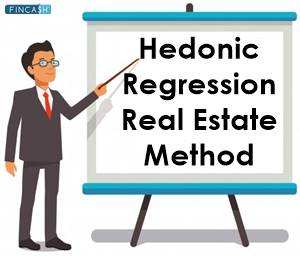
Table of Contents
What is the Hedonic Regression Real Estate Method?
Using a regression model to assess the influence of numerous factors on the price of a good, or occasionally the demand for a commodity, is known as hedonic regression. In this method, the good/service or asset is fractated into constituent parts or characteristics. This determines the contributory value of each characteristic separately through regression analysis.

The dependent variable in a hedonic regression model is the price (or demand) of the good. In contrast, the independent variables are the characteristics of the good that influence the value for the buyer or consumer of the commodity. The weights that purchasers place on the various qualities of the good might be understood as the estimated coefficients on the independent variables.
Briefly Understanding Hedonic Pricing
In Hedonic Pricing models, hedonic regression is utilized, and it is extensively used in Real Estate, retail, and Economics. Hedonic pricing is a revealed-preference method used in economics and consumer research to establish the relative relevance of the variables influencing a good's price or demand. Suppose the price of a home is impacted by various factors, such as the number of bedrooms, bathrooms, and proximity to schools. In that case, regression analysis can be used to establish the relative relevance of each variable.
The hedonic method estimates the extent to which many factors influence the price of a product or a piece of real estate, such as a house, using conventional least squares or more complex regression techniques. The dependent variable is the price, which is regressed against a collection of independent factors that influence the price, either on economic theory, the investigator's intuition, or consumer research. An inductive strategy, such as Data Mining, can also screen and choose the variables to include in the model. The selected features of the good (known as attributes) might be expressed as continuous or dummy variables.
Here is the hedonic regression function:
P = (loc, acc, nei, str, env)
Here,
- p is the property price
The explanatory variables are the features that influence a property's price, such as:
- The features of the location, such as urban, rural, distance from the city centre, and so on, are called loc.
- str denotes the property's structure, such as the number and size of rooms, the size of the lot, the age of the property, and so on.
- acc refers to the property's accessibility, such as proximity to social facilities, public transportation access, and so on.
- Environmental quality, such as air quality, water quality, and so on, is referred to as env.
- nei stands for neighborhood qualities, such as crime rate, scenic vistas, school quality, and so on.
Talk to our investment specialist
Hedonic Regression Real Estate in Practice
The housing Market is a common example of the hedonic pricing method, in which the characteristics of the property itself determine the price of a building or piece of Land, as well as the features of the surrounding environment, and is accessible to schools and a downtown area, the level of water annexed.
Hedonic regression is also employed in constructing the consumer price index (CPI) to account for changes in product quality. Any good in the CPI basket can be represented as a function of attributes, and the projected influence on the price can be determined when one (or more) of these attributes changes. By adding or deducting the projected value of that change from the item's worth, the hedonic quality adjustment approach eliminates any price discrepancy ascribed to a difference in quality.
Hedonic Regression Example
The hedonic pricing mechanism is used in the housing market as an example. The property's attributes, such as appearance and size, and the surrounding environment's elements, such as proximity to school, crime rate, and so on, impact the building price. Hedonic regression models regress one unit's commodity price on a function of the model's attributes as well as the time variable in most cases.
The assumption is that a model pricing sample and the corresponding model vector attributes can be collected throughout two time periods or more. Hedonic regression can also determine the consumer price index and control the consequences of changes in a product's quality. By either adding or removing the changes estimated value from the old item's price, this approach of hedonic adjustment frequently removes price differentials ascribed to quality change.
Advantages of Hedonic Regression
- The method may be easily modified to account for the various possible connections between environmental quality and the marketed commodities.
- This method is frequently used to approximate values based on people's actual selections.
- Because it is reasonably efficient in responding to information, the real estate market is a good indicator of values.
- It is easier to gather data on property sales and attributes, and it may be compared to secondary data sources to produce descriptive variables for regression analysis.
Limitations
- The scope of this model's use is confined to calculating the environmental benefits associated with housing prices.
- The data amount that must be collected and processed is enormous.
- One of the model's assumptions is that everyone should be aware of the potential positive and negative externalities of real estate property purchases.
- The time and money required to carry out a model application are directly proportional to the availability and accessibility of data.
- The model is difficult to interpret and necessitates extensive statistical knowledge and skill.
All efforts have been made to ensure the information provided here is accurate. However, no guarantees are made regarding correctness of data. Please verify with scheme information document before making any investment.












